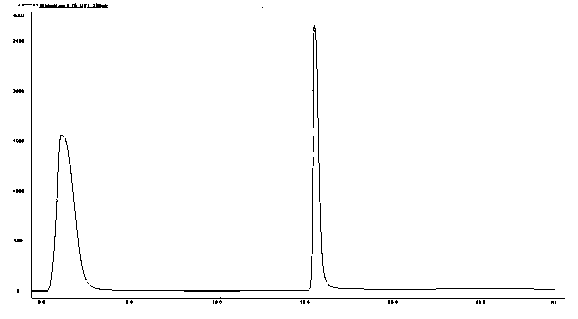Hybridoma cell line of Escherichia-coli O157:H7 resistant monoclonal antibody
A monoclonal antibody, O157 technology, applied in anti-bacterial immunoglobulin, biochemical equipment and methods, instruments, etc., can solve the problems of high cost, high cost, not easy to popularize in grassroots units, etc., to improve detection sensitivity and detection. high efficiency, strict prevention of missed detection and false detection, and good sensitivity
- Summary
- Abstract
- Description
- Claims
- Application Information
AI Technical Summary
Problems solved by technology
Method used
Image
Examples
Embodiment 1
[0021] Example 1 Escherichia coli O157: Preparation of H7 Antigen Bacteria Liquid and BALB / c Mouse Immunization
[0022] The standard Escherichia coli O157:H7 (ATCC11229) stored at -80°C in this study was taken, cultured in broth, cultured on LB by streaking method, enriched by conventional methods, centrifuged at 6000r / min for 10min, and the bacterial precipitate was collected. Colony counting (2.0 × 10 8 CFU / mL), adding formaldehyde with a final concentration of 0.3% overnight at 4°C to inactivate the bacteria. The next day, the eluted bacterial liquid was subjected to ultrasonic waves under the conditions of 20KHz and 150W ice bath to break the bacterial cells, each time for 10 seconds, with an interval of 10 seconds, and a total time of 20 minutes. BCA protein assay kit was used to measure the bacterial protein content, and the result was 2.636 mg / mL.
[0023] Eight-week-old female BALB / c mice were used for immunization. The above-mentioned inactivated bacteria soluti...
Embodiment 2
[0024] The mensuration of embodiment 2 immune mouse serum antibody titer
[0025] After 3 immunizations, blood was collected from the tail of the mice, and the serum titer was detected by conventional indirect ELISA method. Wherein, the coating antigen is the Escherichia coli O157:H7 bacterium liquid prepared in Example 1, the dilution is 1:50, the mouse serum concentration is the gradient concentration starting from 200× dilution, and the enzyme-labeled secondary antibody is HRP (horseradish peroxidase) labeled rabbit anti-mouse IgG (1:15000 dilution). The assay results showed that the antibody titer was 1:25600.
Embodiment 3
[0026] Example 3 Escherichia coli O157: Preparation of H7 monoclonal antibody
[0027] (1) Establishment of hybridoma cell lines
[0028] ①Preparation of feeder cells: Normal BABL / C mice were killed by dislocation of the neck, and 8 mL of HAT culture solution was injected into the peritoneal cavity, and the culture solution was drawn out after gently shaking the mouse for a few times, and the cell concentration was adjusted to 10 5 cells / mL, added to a 96-well cell culture plate, 100 μL per well, and cultured overnight in a cell culture incubator for later use. These are feeder cells.
[0029] ②Cultivation of myeloma cells and preparation of cell suspension: Myeloma cells (SP2 / 0) were resuscitated one week before fusion, passaged every other day, and fusion was carried out one day after passage. Take about 4 bottles (25cm 2 ) SP2 / 0 cells, blow down the cells in each bottle with RPMI-1640 culture medium, centrifuge at 1200r / min for 10min, repeat 2-3 times, and count with a ...
PUM
| Property | Measurement | Unit |
|---|---|---|
| Molecular weight | aaaaa | aaaaa |
Abstract
Description
Claims
Application Information
 Login to View More
Login to View More - R&D
- Intellectual Property
- Life Sciences
- Materials
- Tech Scout
- Unparalleled Data Quality
- Higher Quality Content
- 60% Fewer Hallucinations
Browse by: Latest US Patents, China's latest patents, Technical Efficacy Thesaurus, Application Domain, Technology Topic, Popular Technical Reports.
© 2025 PatSnap. All rights reserved.Legal|Privacy policy|Modern Slavery Act Transparency Statement|Sitemap|About US| Contact US: help@patsnap.com



